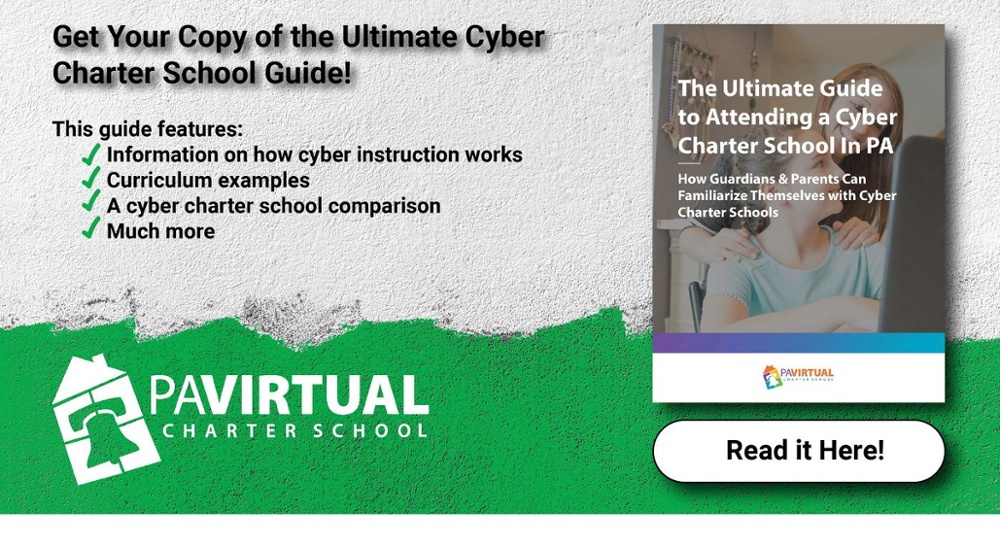Synchronous and asynchronous are big words that can have a big impact on your online education experience. What do they mean? Is one better than the other? How do you know which one you will prefer without experiencing it? When I attended PA Virtual, I had my share of synchronous and asynchronous courses. Today, we will walk through their mechanics, personality traits that fit well with each, and their strengths and weaknesses. By the end of our time together, you should have a better idea of which instructional mode would be the right fit for you or your student, which will make your cyber charter education an even more profitable experience.
What do the big words mean?
Synchronous, or sync, classes have live instruction from a teacher through online classrooms. Students can see their teachers through a webcam, interact with their classmates through a chat box, and participate with a microphone and whiteboard privileges. During live class, students have the opportunity to befriend their classmates and complete group assignments.
Asynchronous, or async, classes have no live instruction. Students work from a plan written by a teacher, who is available to assist through email and other communication methods. Based on the teacher’s plan, students read textbooks, view videos, complete assignments, and take assessments. Because there is no live element to class, students in asynchronous classes can finish their plans when it best fits their schedule.
Are sync classes right for me?
Here are some characteristics that indicate synchronous instruction will help you excel.
You like to learn through discussion.
Depending on the subject, sync classes will have a discussion component or be almost entirely discussion oriented. If you like to bounce ideas off other people or debate, sync classes could be a great choice for you.
For example, in English class, you could read a Shakespearean play and be lost as to thematic content. Once you are in class, however, your teacher might have you and your classmates choose a side and back up your arguments from the text. Through discussion, the themes and the play itself can become clearer.
You find it easier to grasp something when you can ask questions.
Because sync classes are live, you can ask questions in real time when something doesn’t make sense or if you need more clarity. For example, math was never my strongest subject, so I preferred synchronous instruction for my math classes. If the information on the whiteboard confused me, I could raise my hand or type in the chat box for clarification. This helped me to move at my own pace and kept me from getting behind.
You enjoy interacting with people.
In my sync classes, going to class itself was one of my favorite parts. I loved to log into class a few minutes early to chat with my peers. Group work, while sometimes frustrating, was usually worthwhile because I laughed with my friends. Even though I am an introvert, I still love people. For that reason, I often took advantage of the synchronous option to be with people in class.
You prefer a set schedule.
Sync classes are on a schedule that does not change. When you have a synchronous class, you know you are expected to be in the online classroom during the hours that the class meets. For students who prefer a consistent and structured routine, sync classes often work well.
Are async classes right for me?
Here are some characteristics that successful asynchronous learners usually possess.
You like to learn on your own.
Although teachers are available during regular school hours to offer support, asynchronous learning is primarily the responsibility of the student and the Learning Coach. You don’t prepare the list of resources and assignments for yourself, but you complete them independently.
To contrast the earlier sync class example, imagine you read a Shakespearean play for English class. You have a short essay to write about the themes, but the themes aren’t entirely clear to you. Using the resources laid out in your weekly plan, you work through the text. Once you understand the themes, you can find textual examples and write your essay.
You are a more active learner.
Active learners prefer to wrestle through material on their own, asking for help when they need it. In a math class, this may look like reworking problems until a concept clicks. In science, this could be trying an experiment multiple times. In English, active learners may reflect on their readings without being prompted by a discussion.
You prefer to make your own schedule.
Students often choose async classes because of special circumstances. These students chose the cyber charter model so they could also pursue dance, music, or athletics. However, some students just prefer a variety to their day. If you would like to wake up in the morning and decide whether you will start with history or save that work for later, you might prefer async classes.
You are organized enough to keep your own schedule.
Successful async students can motivate themselves to complete their work. Having goals to work ahead and the attitude “work first, play later” helps students succeed asynchronously. If you are more likely to work longer on Thursday to keep Friday shorter, you may be self-disciplined enough for an async class.
It is easy to see the appeal of asynchronous classes, because of the freedom and flexibility. However, in order to actually be educated, async students have to be responsible, as well. Not every student can find success in asynchronous classwork. That’s why we outlined characteristics that you can recognize in yourself, so you can make an informed decision about your learning path.
Continue reading below...
Strengths and Weaknesses of Sync Classes
Strengths
As we discussed earlier, sync classes are live and take questions in real time. For many students, it is beneficial to have class discussion and get their questions answered right away.
Sync classes also provide a wonderful opportunity to make friends in your pajamas. I still look back fondly on my time in sync classes at PA Virtual because I made wonderful memories. There aren’t many places in life where you are judged only by who you really are. No one can see your bedhead at 8 AM. Your classmates may only see your name, but they know you as the personality you bring to class. Maybe you’ll be the funny one, or the one who always has an answer, or the one you can count on to volunteer. Regardless, the sync class format allows for friendships built on substance.
Weaknesses
Although live sync classes can benefit the learning process, they do limit the flexibility of schedules. Class times do not change. Doing work in a different order to shake things up is not an option.
Additionally, being in a synchronous class with other students means that all of those students are learning at the same pace. For students who need extra support, they can fall behind and struggle to catch up if they are not advocating for themselves. For advanced learners, they may grasp a concept more quickly and find themselves bored. PA Virtual does place students in classes that are paced most appropriately for their learning, but in a class of more than one, inevitably, students will move at different paces.
Strengths and Weaknesses of Async Classes
Strengths
One main benefit of async classes is the flexibility. Responsible students are rewarded with the ability to craft their own schedule and build in variety. Often, async students take advantage of opportunities to be involved in extracurricular activities that would not be possible with a synchronous class schedule.
Alongside the flexibility, async students can learn entirely at their own pace. As a class of only one, boredom or falling behind are not concerns. If a concept takes longer to grasp, it takes longer to grasp. When it clicks, it clicks.
Weaknesses
Your teacher is only available during normal school hours. If your async schedule has you working from 5 PM until 10 PM each night, any emails you send will be answered during your teacher’s hours. It can be frustrating to not have immediate answers like you would in a sync class.
Because async classwork hours are up to you, it can also be difficult to form a routine. Even once a routine is established, it can be tempting to procrastinate or ignore the routine. This is why looking at yourself and your personality is so important when deciding between synchronous and asynchronous classes. If you are self-motivated and independent, the strengths of async classes outweigh the weaknesses. However, without those key traits, even the strengths can become weaknesses to your education.
So which do I choose: sync or async?
PA Virtual offers both synchronous and asynchronous classes because different models accommodate different learning styles and needs. Some students have more of the sync class characteristics, and therefore that model is a better fit. For other students, they have the independence and responsibility to excel in the async model. Here are some tips for choosing between synchronous and asynchronous courses.
Mix it up.
For some students, a mix between sync and async plays to their strengths. When I was at PA Virtual, I always took synchronous math classes because it was not my strongest subject. While I could have completed English asynchronously, I usually chose synchronous classes because I loved interacting with my teachers and classmates. The right model might look different for each subject, and trial-and-error is okay.
Both models have their strengths and weaknesses.
Neither model is foolproof, and both require a hands-on Learning Coach willing to work alongside the student and staff. However, depending on your personality and your strengths, the benefits may outweigh the disadvantages for you.
In either model, students and Learning Coaches work together.
When I was in elementary school, the majority of my classes were async. My mother, who acted as my Learning Coach, played a huge role in my success. Most elementary school students who have the independence to excel in async classes are still learning the responsibility and self-management skills they will need in the future. While younger students are learning and growing, Learning Coaches shoulder a larger part of the responsibility.
Hopefully this guide helped you to think more critically about your education and your style of learning. No matter which class model you choose, PA Virtual is here to come alongside you with a rich education.
If you're interested in learning more about a day in the life of a synchronous student, check out our blog post here. Alternatively, if you'd like some insight on a day in the life of an asynchronous student, you can read this blog post.
If you think cyber schooling may be a good fit for you, we invite you to check out our Ultimate Guide to Attending a Cyber Charter School in PA. This comprehensive guide includes a comparison of cyber schools and examples of curriculum, and it can help you decide whether cyber school would benefit you and your family.
 About the Author: Alexis Dingeldein attended PA Virtual for all of grade school and graduated in 2017. During her time at PA Virtual, she wrote and self-published six novels. She is currently at Geneva College studying business and writing.
About the Author: Alexis Dingeldein attended PA Virtual for all of grade school and graduated in 2017. During her time at PA Virtual, she wrote and self-published six novels. She is currently at Geneva College studying business and writing.






Comments